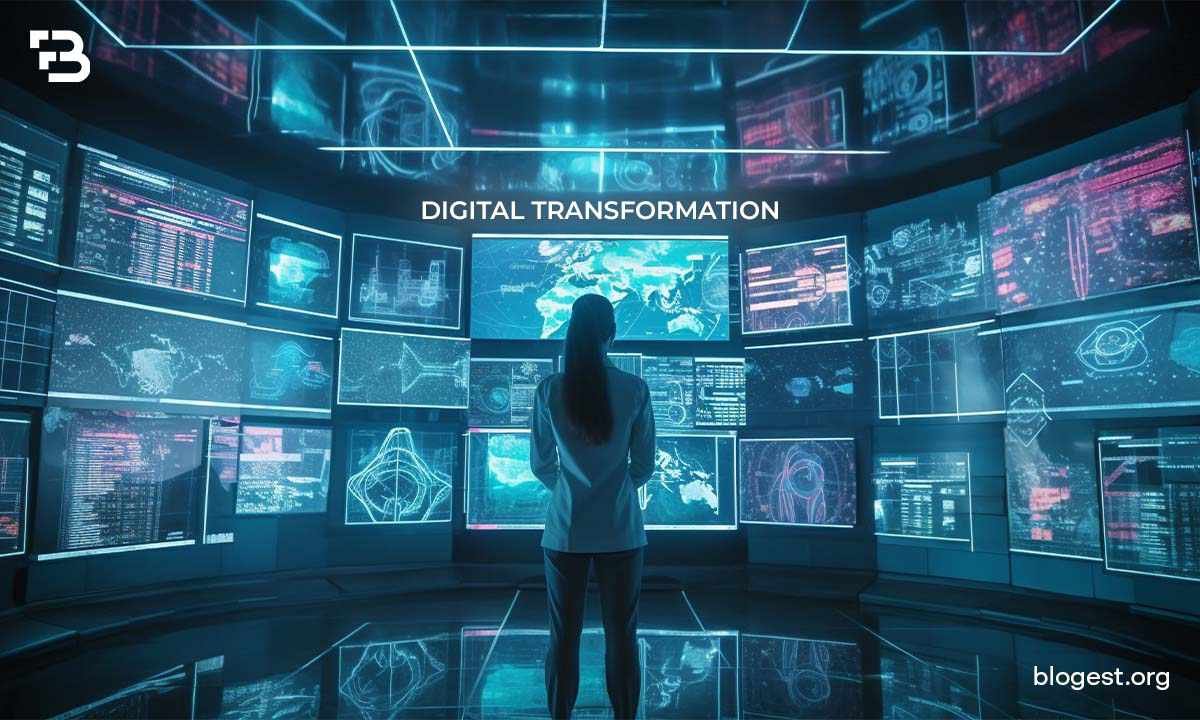Ever wondered about the cool makeover happening in education? Well, it’s called Digital Transformation in the education industry!
Imagine making learning a blast for students, mentors, and alumni, plus making admin tasks a breeze. How?
By using fancy tech to simplify things!
Here’s the scoop.
- Sign up for classes in a snap.
- Dive into super interactive and fun learning.
- Get awesome results from your hard work.
- Study from your phone, laptop, or whatever suits your vibe.
- Keep track of your grades like a pro.
- Watch as the whole school/college/university runs like a well-oiled machine!
- Digital transformation is like giving education a high-tech high-five!
Digital Transformation in Education: Key Technologies and Trends

The dynamic landscape, accelerated by the pandemic, beckons educators to embrace innovation, redefine methodologies, and usher in a new era of learning.
In this exploration, we delve into the multifaceted realms of education, where technology emerges as a catalyst for change, shaping the way institutions connect with students, optimize administrative processes, and revolutionize the teaching and learning experience.
1. Artificial Intelligence
Education’s digital maestro – Artificial Intelligence!
Picture this technological marvel taking on the nitty-gritty tasks, granting our devoted educators a well-deserved respite.
But wait, there’s more! Let’s unravel the fascinating facets of AI in education.
(a) Elevating Student Triumph: Envision the enchantment of your spoken words seamlessly transforming into class notes – a boon for students with hearing impairments.
For those grappling with dyslexia, AI steps in, transmuting text into soothing voices, revolutionizing the learning experience.
(b) Tailored Learning Journeys: Ever yearned for an education tailored to your unique learning style?
AI makes dreams come true! Blended and adaptive learning techniques meld traditional teaching with cutting-edge digital tools, empowering you to explore and grasp concepts at your own rhythm.
(c) Empowering Faculty: AI isn’t solely for students; it’s a faculty ally too. Enter intelligent chatbots – virtual consultants answering all queries about classes, homework, and campus intricacies.
These digital assistants liberate professors to focus on the heroic aspects of teaching.
(d) Navigating College Complexities: Stressed about college admissions? Fear not! Admission-focused chatbots are here to guide you through the labyrinthine process, offering clarity and support.
(e) Unveiling Behind-the-Scenes Enchantment: Educational enterprises harbor a trove of backstage intricacies. Introducing process mining – a detective-like prowess uncovering inefficiencies in the financial realms of education.
(f) Time-Bending Technology: Meet RPA, the temporal sorcerer! Whether handling individual tasks or orchestrating a symphony of hyper-automation, RPA eases the burdens on support staff, bending time to their advantage.
Artificial Intelligence – the avant-garde virtuoso revolutionizing education, one digital masterpiece at a time!
2. Virtual Reality and Augmented Reality
Let’s explore the wonders of Augmented Reality and Virtual Reality (AR/VR)! These tech marvels can craft interactive and virtual realms for students, making subjects more captivating.
Picture embarking on virtual field trips to historical spots or diving into hands-on learning adventures in applied sciences and medicine.
And guess what? AR/VR can even sprinkle some magic on distance learning, making the experience way more exciting!
3. Analytics
Thanks to digital technologies, schools can gather a treasure trove of data about their students to track and boost their performance.
Through a mix of traditional and advanced analytics, educators can pinpoint areas where students face challenges or excel, create innovative teaching approaches, and assess if these methods bring about the anticipated improvements.
It’s like unraveling the secrets of student success through the magic of data!
4. Online Learning
Let’s chat about the quick shift to distance learning (or remote learning) using Zoom or Skype – a rapid response by schools and colleges during the pandemic.
Now, check this out: educational institutions can go a step further by creating their own online class setups, often known as learning management systems (LMS).
By seamlessly blending these systems into their websites or platforms, they can tailor the online learning adventure to match the unique needs of learners or the specific course content.
It’s like crafting a personalized digital learning universe!
5. Internet of Things or IoT
Let’s talk about the rise of smartphones and other nifty-edge devices!
They’re leveling up the connection between students and their schools, making real-time communication and data transfer a breeze.
Plus, IoT devices aren’t just cool gadgets – they can keep tabs on little ones, letting teachers and parents know if they’re present or absent in class, ensuring their safety.
It’s like technology weaving a safety net around our education journey!
6. Smart Classes
Let’s shine a light on how digital technologies have jazzed up traditional face-to-face learning!
Enter smart classes, decked out with smart boards, computers, internet connections, projectors, and more.
These high-tech setups open up new avenues for delivering learning resources to students, making things possible that were once unimaginable with just a blackboard and chalk.
It’s like upgrading the classic classroom to a tech-savvy learning hub!
Digital Transformation in Education: Key Areas
Following the frosty funding setback in 2022 for the Edtech sector, the outlook is considerably brighter in 2024.
The rise of hybrid learning takes the spotlight as a pivotal trend in achieving profitability, especially with BYJU’s taking the reins at Aakash and the emergence of the new unicorn, PhysicsWallah.
Whether delving into inventive learning approaches or leveraging technology to elevate the student experience, we’re set to explore how technology plays a role in enabling institutions to deliver top-notch education.
1. Revolutionizing Admissions with Technology
The traditional admission process is notorious for its time-consuming rituals, with students queuing up to submit documents and admission forms.
Frequent institution visits to track application status add to the hassle.
On the administrative end, teams sift through documents, verify eligibility, shortlist candidates, and keep them informed.
While the pre-pandemic system had its merits, the new-age admission process calls for a digital overhaul to simplify things for everyone – parents, students, teachers, and administration alike.
Enter the comprehensive admission management system, offering the following perks.
- Institutions bid farewell to paperwork headaches linked to admissions.
- Technology steps in to autonomously identify eligible candidates.
- An automated response system takes routine inquiries off counselors’ plates.
- Institutions gain real-time insights into courses, faculties, and student updates.
- Students bid farewell to queues, saving time on application status checks.
- Applying to multiple institutions becomes a breeze, all without setting foot on campus.
2. Streamlining Administration through Technology
Modernizing daily administrative tasks has become a breeze with technology.
From handling class schedules to processing administrative requests and storing documents, tech integration enhances counselor productivity, minimizes human error, and establishes robust processes that scale seamlessly.
Shifting certain administrative processes online has yielded numerous benefits.
- Enhanced cloud security elevates document storage and management.
- Productivity gets a boost with timely reminders and optimized schedules.
- Service level agreements (SLAs) and process documentation expedite query resolution.
- Technology empowers administrators, teachers, and counselors to focus on core responsibilities, eliminating the need for manual and repetitive tasks.
3. Revitalizing EdTech Strategies
Amid the pandemic-driven surge in online course interest, EdTech companies embraced CRM software, foreseeing a $404 billion boost in spending over the next five years.
Despite the return to normalcy in schools and universities, EdTechs thrive with hybrid learning and self-paced modules. Here’s how online educators leverage CRM.
Student Inquiry Handling: EdTech CRM streamlines capturing and directing inquiries from diverse channels for faster conversions.
Student Intent Monitoring: CRM captures valuable data, aiding enrollment reps in pitching relevant courses.
Lead Scoring and Prioritization: EdTech CRM assigns scores for actions, prioritizing higher-scoring leads for enrollment follow-ups.
Data-driven Analytics: EdTech CRM tools offer comprehensive metrics for informed decision-making on calls, leads, campaigns, and more.
4. Revolutionizing Teaching & Learning Approaches
The pandemic nudged educational institutions toward a hybrid education model, gaining traction with BYJU’s recent acquisition of Aakash. Tech interventions redefine learning.
Video Integration: Initially reliant on tools like Zoom, institutions now seamlessly integrate video into their websites, recreating a dynamic digital classroom experience.
AR/VR Learning: Augmented and Virtual Reality breathe life into subjects like History and Biology. Case in point: Cleveland Clinic’s use of AR for anatomy training.
Gamification: Fun learning prevails, with gamification aiding retention in K12 and professional courses.
AI/Predictive Learning: Borrowing from Netflix’s recommendation model, AI suggests related topics, enhancing student interest and deepening course engagement.
Interactive Video and Media: Beyond traditional smart classes, interactive content holds attention. Techniques like Google Digital’s timely responses ensure focus amid digital distractions.
Smart Exam Portals: Tackling exam challenges, institutions deploy webcams on online portals to deter unfair practices, ensuring exam integrity.
Learning Experience Platform (LXP): Unlike rigid Learning Management Systems, LXP maps a student’s journey dynamically, offering personalized content based on pace and preference.
Digital Transformation in The Education Industry: Challenges to Overcome
Despite the pandemic accelerating technology adoption, many institutions cling to traditional teaching methods, presenting challenges in education transformation.
Lack of Clear Strategy & Willingness To Change
The rush to return to normalcy after the pandemic has hindered technology adoption, with a slow shift from physical to virtual classes. Justifying tech investments becomes challenging without a clear strategy.
The sector’s reliance on personnel and non-user-friendly systems leads to higher training costs and delays in process changes. A phased, well-tracked strategy for introducing technology across various education aspects is crucial.
Insufficient Tech Knowledge
Teachers and staff focused on student support, often struggle with complex technologies. User-friendly tools, like LeadSquared, with centralized platforms for automation and student data, witness higher adoption rates.
Regular training programs are essential to keep staff updated, fostering partnerships with tech tools for increased adoption.
Dealing with System Breakdowns
Institutions face scrutiny on compliance and secure data handling. Technical glitches and errors, coupled with limited tech knowledge, heighten the risk of breakdowns and external dependencies.
Investing in stable, secure, and scalable technology is crucial for timely issue identification and resolution.
Now, let’s explore how a leading online GMAT training institute embraced technology to enhance overall student experiences.
May You Like Also: Digital Transformation in Different Industries
Final Talks
In the dynamic landscape of education, the fusion of tradition and technology unfolds a realm of possibilities. As we tackle challenges and embrace innovations, one truth emerges – the future of education is intricately woven with technology.
From chatbots to AI and digital platforms, each advancement propels us towards a future where learning is personalized, interactive, and accessible, shaping a brighter global community with digital transformation in the education industry.
You May Like Also:




